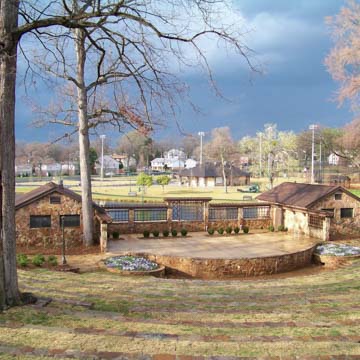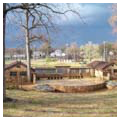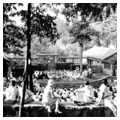Avondale Park in Birmingham, Alabama, is the central landscape of the surrounding historic district. The park’s development has reflected changes in the Avondale neighborhood since the community was established over two centuries ago. Avondale Park protects an abundant natural spring called “Big Spring,” also known as “King’s Spring” and “Cave Spring.” The spring was the focal point of the rural community established by migrants from Georgia, South Carolina, and Virginia who settled in Birmingham’s Jones Valley as early as 1816. In 1865 an Alabama lawyer and land speculator named Peyton King purchased a 1,640-acre homestead from settler Abner Killough of Kentucky. King built a house and lived there with his family until 1886, when he sold the land to speculators with a provision preserving the 40 acres surrounding the spring for recreational use. That same year, the newly formed Avondale Land Company used those 40 acres to establish a public park for the new neighborhood of Avondale. The area surrounding this amenity grew quickly: Queen Anne residences, Tudor cottages, and Craftsman bungalows of all sizes populated Avondale into the late 1920s. In 1908, King’s house was demolished and replaced with a Beaux-Arts Carnegie Library. In 1910, Avondale was incorporated into the city of Birmingham.
Avondale Park was the site of Birmingham’s first zoo, which was in operation from 1913 until it was relocated to its current site in 1934. In 1915, a formal rose garden was created in the park, composed of triangular planting beds radiating from a lattice-work gazebo. By 1917, the tree-shaded park also featured a wading pool populated with ducks and swans, sports courts and fields, play equipment, a refreshment stand, and picnic pavilions. A model poultry farm was constructed in the park in 1921, along with a new amphitheater and 6,000-seat grandstand. These improvements, combined with its accessibility via the public street car line, made Avondale the most popular park in Birmingham—for white residents. Only in 1964, after the passage of the Civic Rights Act, was Avondale Park open to everyone in Birmingham regardless of race. Earlier attempts to integrate the park failed, including an outing for African American citizens planned for July 9, 1914. Organized by members of the Sixteenth Street Baptist Church (the same church bombed in 1963), this outing was cancelled after protests from the whites-only Avondale Civic League.
The bustling city of Birmingham was hit hard by the Great Depression. After the 1929 stock market crash, capital investment in the city’s industries dried up; mills and mines shut down, residential construction ceased, and consumer spending dropped. In 1931, almost one-third of Jefferson County’s working-age population was unemployed. City administrators acted quickly and, among other measures, put to vote a $500,000 bond issue to fund park improvements. Landscape architect Rubee Jeffrey Pearse led the renovation of the park’s picnic shelters, amphitheater, rose garden, and rose garden gazebo, and oversaw the design and construction of the park’s entrance gates. Improvements also included the completion of the Villa, an open-air, a French Norman–style pavilion designed by the Birmingham architectural firm Burnham and Greer.
When the U.S. entered World War II, Birmingham began to recover and thrive. After the war, the residential neighborhood around Avondale Park experienced another wave of development as returning veterans moved into houses built with Veterans Administration loans. In the late 1950s and into the 1960s, home builders filled in the remaining lots with sleek ranch houses, some custom-designed by local architects. Avondale Park itself became a popular location for outdoor concerts, including performances by the Alabama Symphony. Also in the postwar period, the 1908 Carnegie Library, located on the park’s busiest corner, was replaced with a low-slung, International Style building that continues to function as the Avondale Public Library.
In the 1960s, Birmingham was one of the most racially segregated cities, which made it an important location for civil rights activism. It was beset by civic unrest and by white flight from the city to surrounding counties. White disinvestment eroded the city’s tax base, and funding to support Birmingham’s public facilities declined precipitously. Avondale Mills, long a key employer in the neighborhood, closed its local operations in the early 1970s. It did not take long for Avondale Park to feel the effects of decline; it deteriorated rapidly in the 1960s and 1970s. By the 1980s, the Villa was so dilapidated that the Parks and Recreation Board closed the building and fenced off its site. Nonetheless, the park remained in use, hosting numerous “hippie concerts” by local bands and even nationally known groups like the Allman Brothers, who played to a sold-out crowd in 1969. The concerts continued through the mid-1970s. By then, the park was well known as a place to purchase and use marijuana and other drugs, leading to the establishment nearby of a free health clinic that treated drug overdoses in and around the park.
In 1989, members of Avondale School’s Parent Teacher Association organized Friends of Avondale Park to address the park’s deteriorated condition. After extensive lobbying, the group convinced then mayor Richard Arrington Jr. to put to public vote a bond issue to support park improvements. The group used a portion of the secured funds to commission a park master plan. Subsequent fundraising enabled the complete renovation of the Villa; Jim Waters and Associates carried out this work, which was completed in 2006. In 2009, additional city funding was used to renovate the amphitheater, playground, athletic fields, and restroom facilities. Local design firm KPS Group led this effort, which was completed in 2011. Today the 36.5-acre park includes the rose garden and gazebo, a WPA-era outdoor amphitheater and the renovated Villa, duck pond, walking track, tennis courts, and youth baseball/softball fields. Today, Avondale Park remains a vital part of the larger community.
References
Brooks, Carolyn, “Avondale Estates Historic District,” Jefferson County, Alabama. National Register of Historic Places Inventory–Nomination Form, 1986. National Park Service, U.S. Department of the Interior, Washington, D.C.
The Cultural Landscape Foundation. “Avondale Park.” Accessed August 16, 2015. www.tclf.org.




















